Wagner Horse Doc
Keith L. Wagner DVM
special report
Central Pattern Generators
A Central Pattern Generators or CPG's are located at different levels in the spinal cord and brain stem. They are a hard-wired component of the spinal cord and brain stem, which coordinates a pattern of muscle movements with muscle groups to perform stereotypical commonly used movements. So, stimulation of CPGs produce walking, trotting or galloping muscle pattern movements of the horse. Non-biomechanical movement CPGs are involved with muscle movements for breathing, chewing and swallowing to name a few. Initiation of CPGs function start in the brain but the CPG is influenced by nervous impute to the CPG. Proper CPG function and timing is required for correct muscle and joint function to occur in a horse’s gait.
When a CPG dysfunction occurs muscle function and timing is affected therefore producing an arrhythmic gait. Also, each CPG has an indicator muscle that becomes paretic or weak due to improper nerve impulse, which are found with muscle testing. Weak indicator muscles can fatigue sooner and become painful. Since all joints are stabilized by the muscle units going across the joint. If a muscle function is weak the joint stabilized by that muscle unit will be unstable or have increase motion or vibration in it. The laxity or increase motion in a joint is a cause of inflammation or arthritis in the joint.
The CPG dysfunction occurs when pain from intraosseous faults, subluxations, muscle spasms along the spinal column and imbrications inhibit the CPG. Intraosseous faults (IOF) are like deep bone bruises just under the surface of a bone. The body will restrict the muscle pull on these areas to reduce the pain response from them. Subluxation as some chiropractors call them are areas of restricted motion of the joints mostly between two vertebrae. Another way of saying it is the vertebra are stuck and not articulating correctly. Imbrications are a jamming or compression of two vertebrae together. The restricted motion decreases impute to the spinal cord creating a deficit in the CPG. Therefore, correcting the CPG dysfunction, improves the timing and function of the muscles involved in movement for riding. Also improving the joint stability reduces the risk of arthritis or lameness.
The most common Central Pattern Generators are listed below. They are the ones generally involved in the biomechanical movement of the horse. Deficits of the CPGs produce arrhythmic gaits, sore muscles, inflamed joints and lameness. These pathological issues are not generally corrected with basic chiropractic adjustments. Along with each CPG listed is a corresponding photo with the weak indicator muscle identified by a blue circle and a red marked area indicating the location of the chiropractic manipulation.
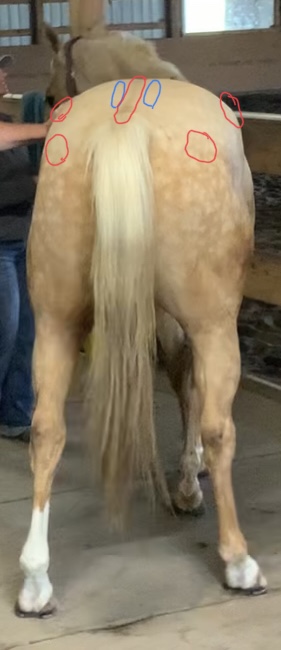
CPG #1 Fight or Flight Gait
CPG#1 Fight or Flight Gait
Chiropractic issues occurring in the upper hindquarter area namely the sacropelvic and upper femur structures result in a dysfunction of the CPG. The weak indicator muscles are the gluteal muscles and biceps femoris muscle along the sacrum.
The Gluteal muscle directly stabilizes the hip but affects the sciatic nerve. While a weak biceps femoris muscle results in instability in the stifle and hock due to the stay apparatus.
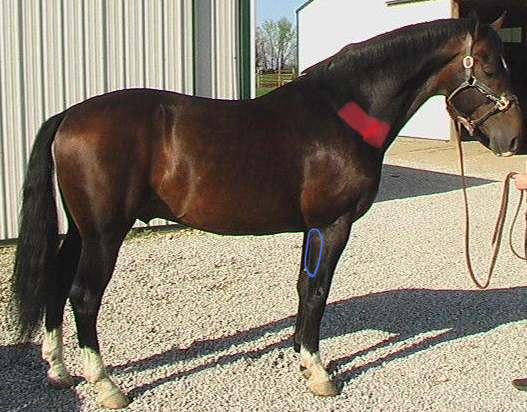
CPG # 2 Ulnaris lateralis
CPG#2 Ulnaris lateralis Gait
Chiropractic issues in the base of neck or first two thoracic vertebrae create this CPG dysfunction.
The ulnaris lateralis is the weak indicator muscle located on back of front leg just below the elbow. The ulnaris lateralis stabilizes the elbow, carpus and fetlock while taking stress off of the superficial and deep digital flexor tendons. A weak ulnaris lateralis transmits a larger percentage of strain to potentially damage the flexor tendons (bowed tendon).
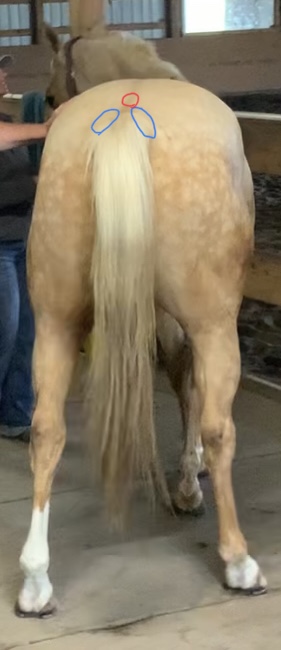
CPG #3 Dorsal Sacral Apex Gait
CPG#3 Dorsal Sacral Apex
Dysfunction will result from a subluxation of the end of sacrum just above the tail head and possible chiropractic issues in thoracic vertebrae 3, 4, 9 or 10. Saddle fit issues may produce this CPG deficit. This CPG will commonly produce an abnormal tail set and movement.
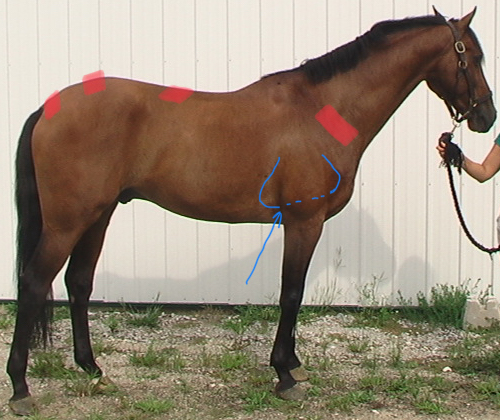
CPG #4 Serratus Ventrales Gait
CPG#4 Serratus Ventralis Gait
Chiropractic issues occur in vertebrae Thoracic1 or T2, Lumbar1 or L2, Sacral1 or S2 and Coccygeal1 or Cx2 creating this CPG dysfunction. The indicator muscle serratus ventralis is a hammock like muscle for the thorax while acting as a type of shock absorber. This weak indicator muscle allows instability in the elbow and knee while increasing the force of foot fall on the lower legs.
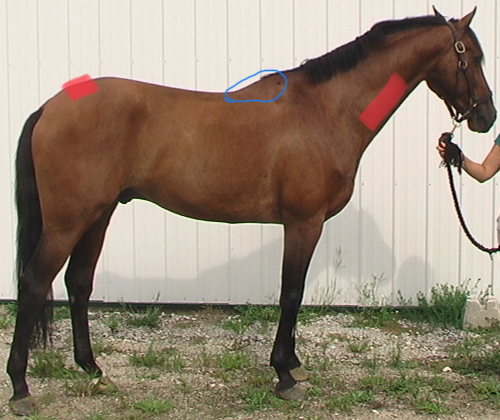
CPG #5 Gallop Gait
CPG#5 (Monkey) Gallop Gait
Dysfunction occurs with chiropractic issues in the sacrum and in mid-neck thereby producing pain in the croup and decrease flexion of the pelvis and neck. Weak indicator muscles are in the chest and just behind the withers. These muscles become sore and reactive creating saddling issues or caused by poor saddle fit. Instability occurs in the foreleg, especially the shoulder and hind leg, especially in stifles and hocks. Horses with this deficit will run with their hind legs striding in unison.
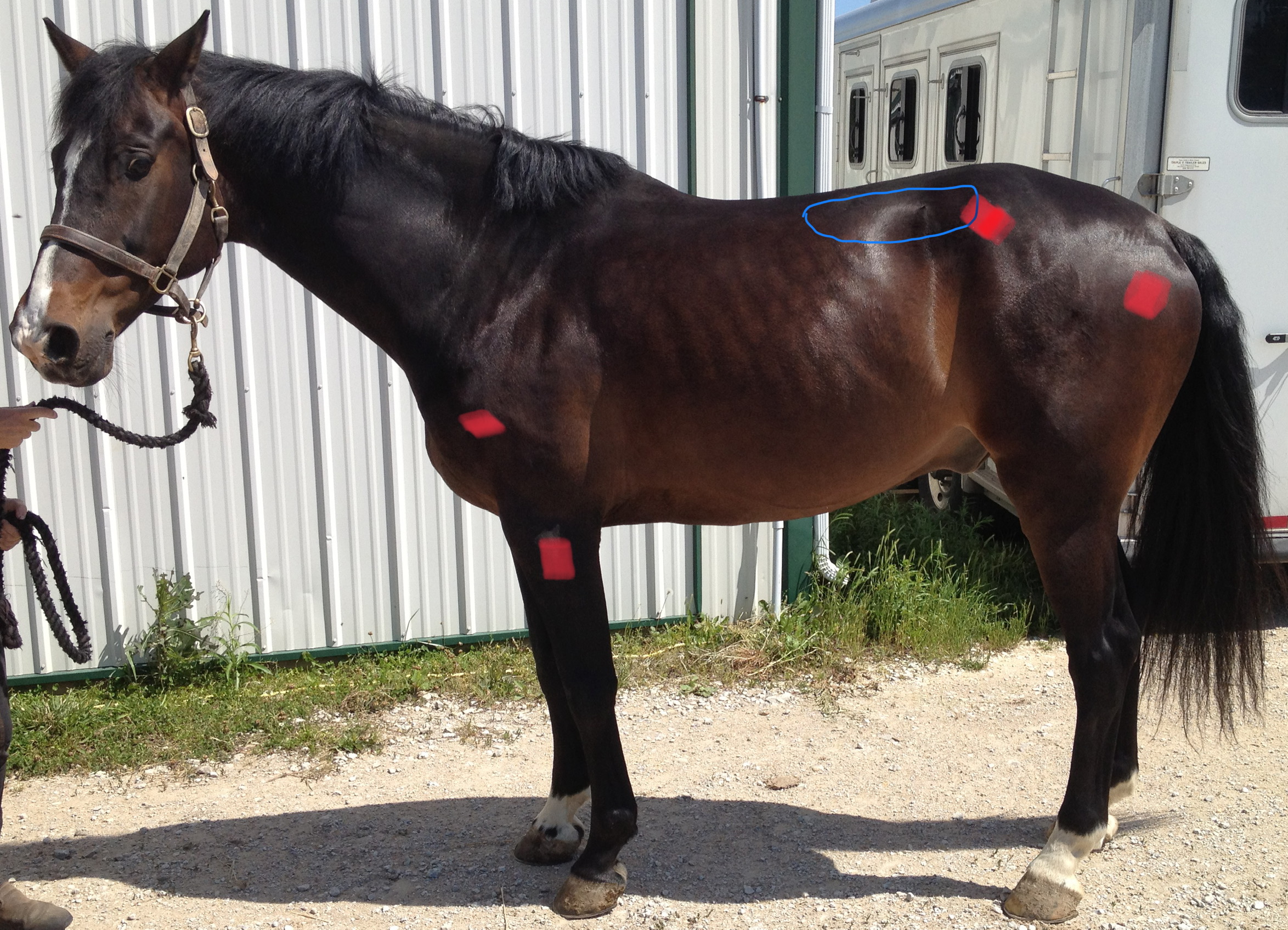
CPG #6 Climbing Gait
CPG#6 Climbing Gait
Dysfunction occurs when there are chiropractic issues in the wing or point of the pelvis, femur of the hind leg and in the humerus and radius of the front leg on the same side. The weak indicator muscle is the Psoas muscle in the lumbar or back area of the horse. These horses will be sore just behind the saddle or possibly reluctant to take a lead. Pain may be found in the sacroiliac joint or upper hind leg. This CPG deficit maybe a component of the kissing spine syndrome in the horse.
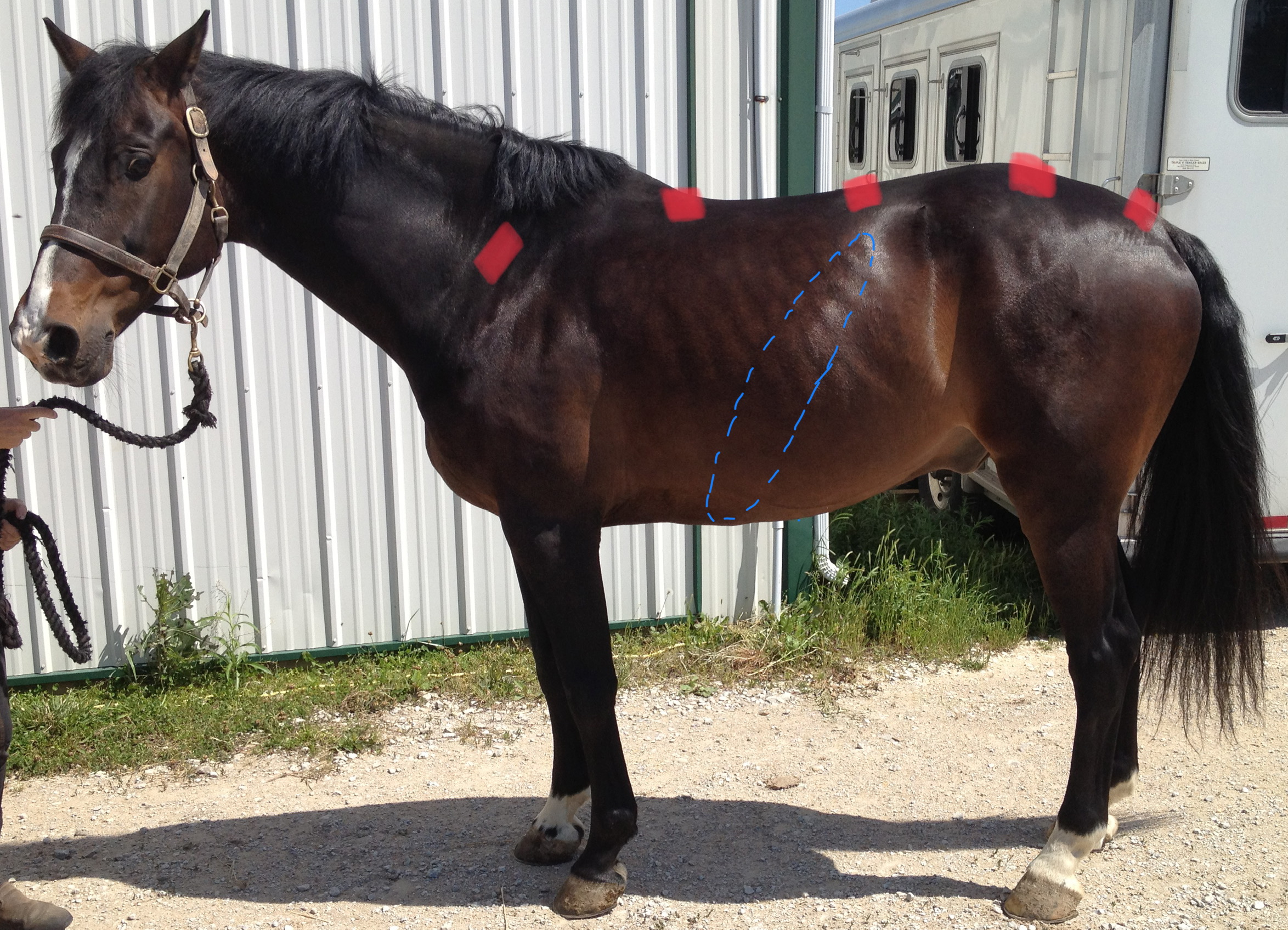
CPG # 7 Curial Gait
CPG#7 Curial or Diaphragm Gait
Chiropractic issues in all of the following vertebrae Throacic2, Lumbar2, Sacral2, Coccygeal2, may also have issue in Throacic14-18 vertebrae. The weak indicator muscle is the diaphragm. When this deficit occurs, the horse may experience biomechanical movement abnormalities or lameness since the diaphragm has to move in conjunction with the legs. Also, this deficit may result in colic signs due to a physiologic diaphragmatic hernia. The weak diaphragm muscle relaxes around the esophagus allowing the negative pressure in the chest to pull an abdominal structure into the hole.
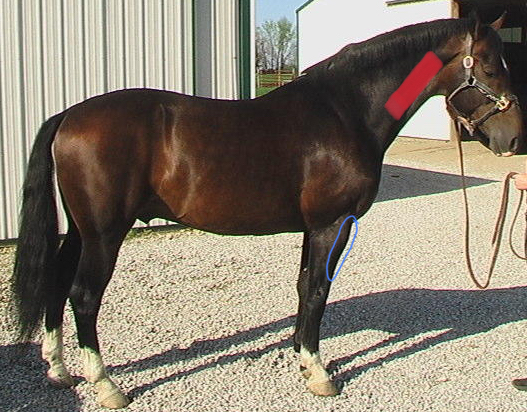
CPG # 8 Extensor. Carpi radialis Gait
CPG#8 Extensor Carpi Radialis Gait
Chiropractic issues in the mid-neck area causes the extensor carpi radialis muscle on the front of the forearm on the front leg to become weak. This muscle brings the lower limb forward and offers stability to the knee, and lower limb joints.
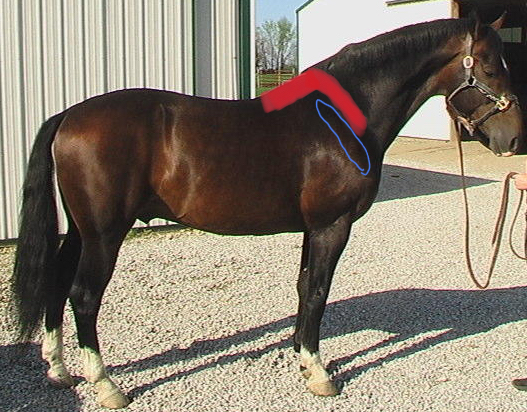
CPG # 9 Lateral Escape Gait
CPG#9 Lateral Escape Gait
Chiropractic issues in the thoracic vertebrae causes the supraspinatus muscle on the front of the shoulder blade to become weak. This muscle stabilizes the shoulder joint.
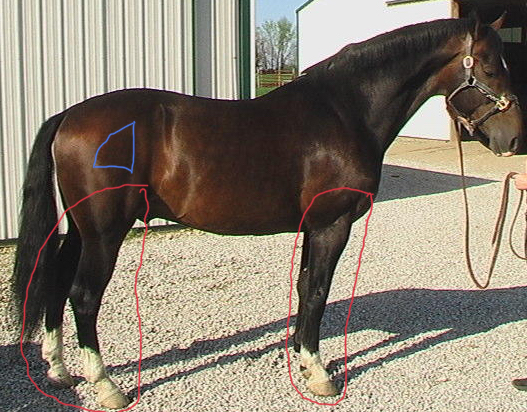
CPG #10 Lateral Bending Gait
CPG#10 Lateral Bending Gait
The indicator muscle is the right tensor fascia lata muscle. This muscle is attached to the point of the pelvis and knee cap. It stabilizes the hip and stifle. Nociception or subconscious pain in one of the legs will cause a dysfunction of this CPG.
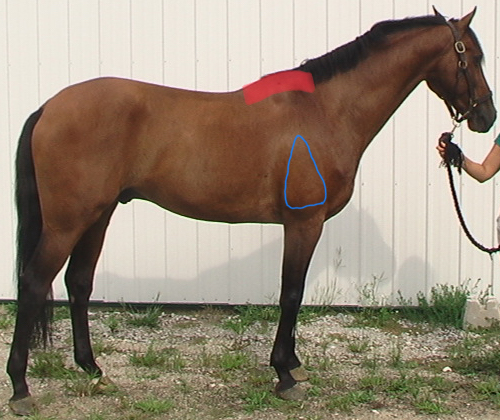
CPG #11 Triceps brcheii Gait
CPG#11 Triceps brachii Gait
The Triceps brachii muscle just above the elbow is the weak indicator muscle. This muscle stabilizes the elbow, knee and fetlock. It is one of the major components affecting the suspensory ligament on the back of the cannon bone. Weakness in this muscle usually proceeds a bowed tendon or suspensory ligament issues. Chiropractic issues in the thoracic vertebrae generally produce this CPG dysfunction.
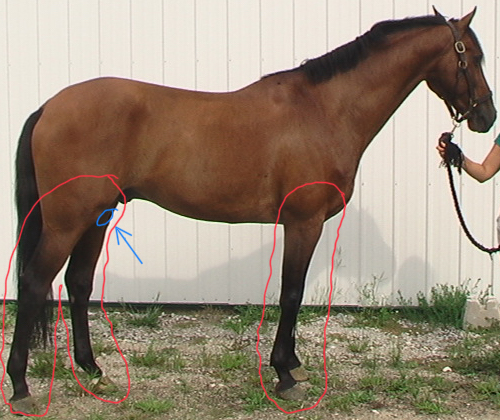
CPG #12 Contralateral Gait
CPG#12 Contralateral Gait
The weak indicator muscle is the left Sartorious muscle on the inside of the stifle. This muscle stabilizes the stifle. With this CPG dysfunction, the stifle can be very sore. Some horses will kick when touching or getting close to the stifle. Usually caused by a nociceptive or subconscious pain response in the extremities.
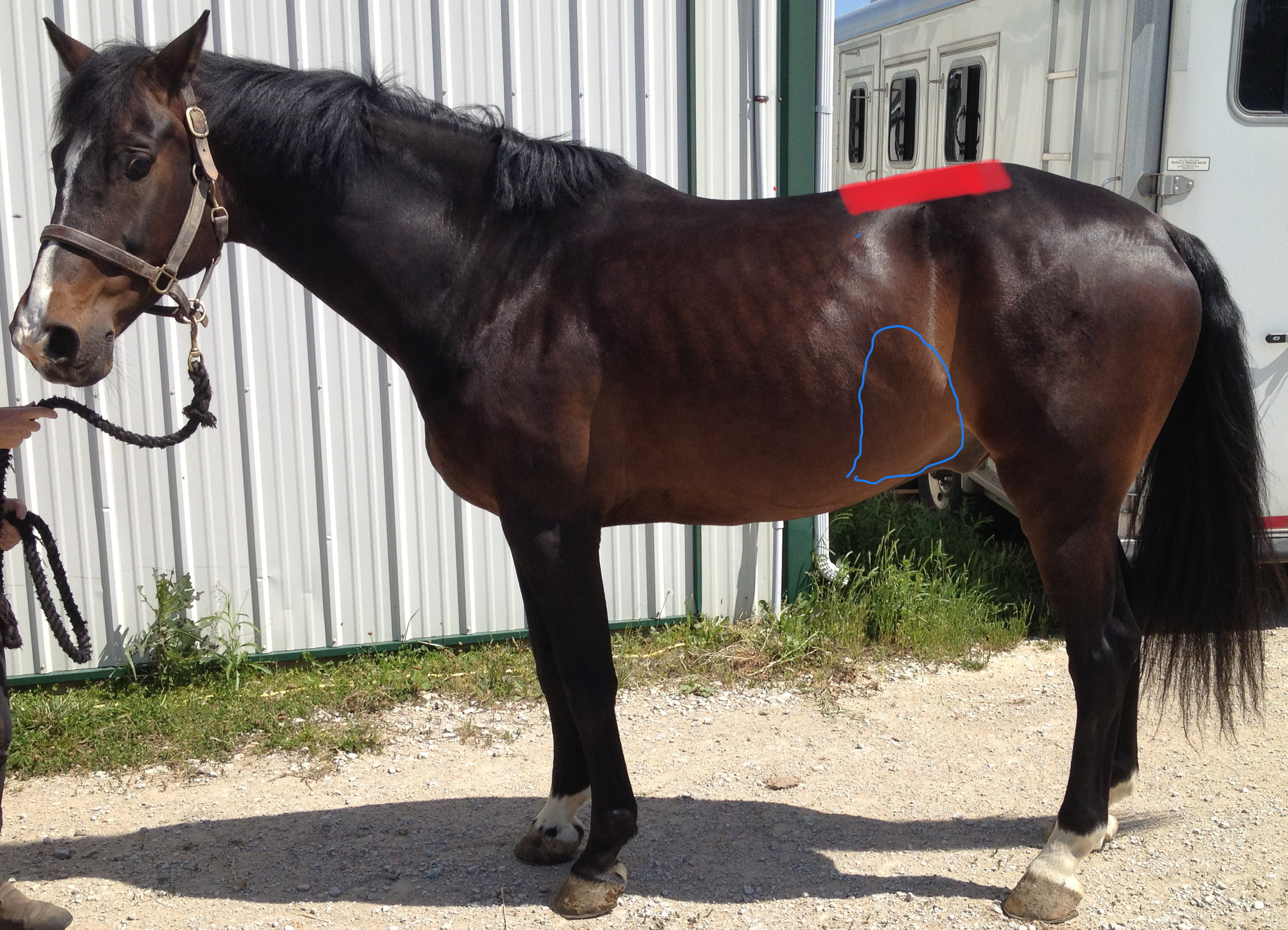
CPG #13 Swing Gait
CPG#13 Swing Gait
Noted as part of the swing phase of the stride in the hind legs, the abdominal muscles on a side and the rump muscles on the opposite side will be the weak indicator muscles. These horses maybe painful acting in the flank region and along the spine from withers to pelvis. Chiropractic issues in the thorax or lumbar vertebrae usually cause this dysfunction.
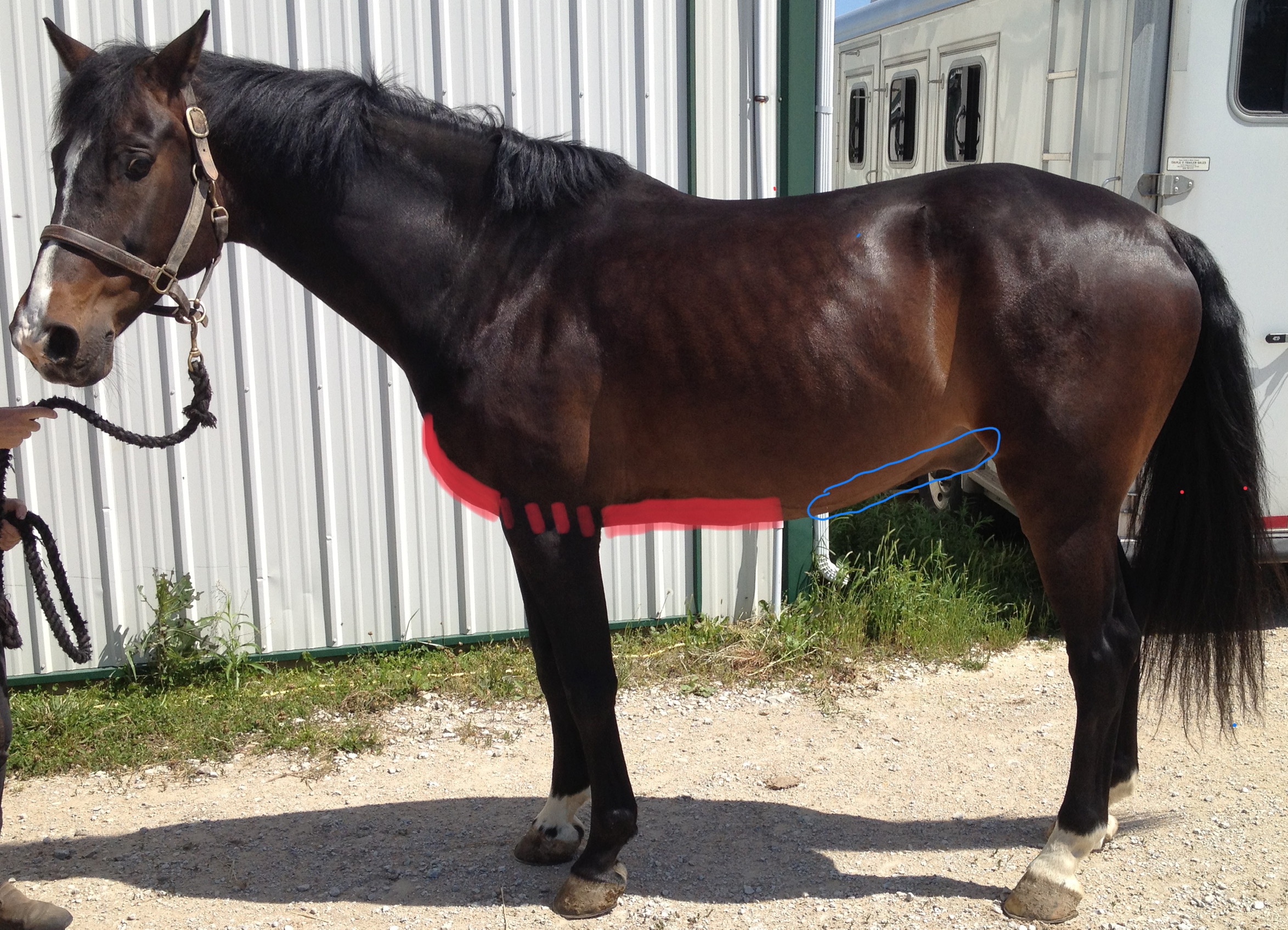
CPG #14 Pelvic Flexion or Hump Gait
CPG#14 Pelvic Flexion or Hump Gait
Weakness in the abdominal muscles on the underside of the horse is the indicator for this CPG dysfunction. These muscles are a major component of the Bow and String Theory in collection of the horse. Chiropractic issues in the sternum will create this CPG dysfunction. It is common for these horses to be cinchy, reluctant to be saddled or touchy on under belly.
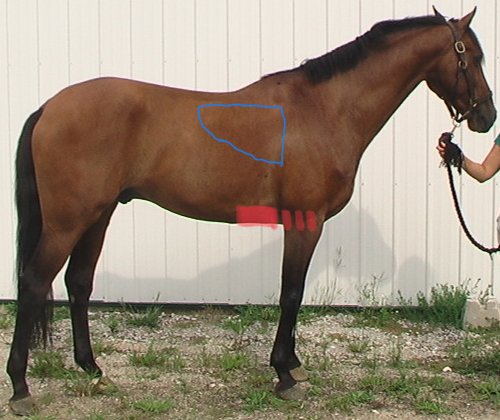
CPG #15 Dive Gait
CPG#15 Dive Gait
The Latissimus dorsi muscle on the sides of the rib cage show weakness with this CPG dysfunction. This muscle stabilizes the shoulder and the junction of the thoracic and lumbar vertebrae. A secondary spasm of the diaphragm may occur also. Usually a chiropractic issue in the skull and sternum cause this CPG dysfunction. These horses maybe head shy and cinchy or not like to be saddled.
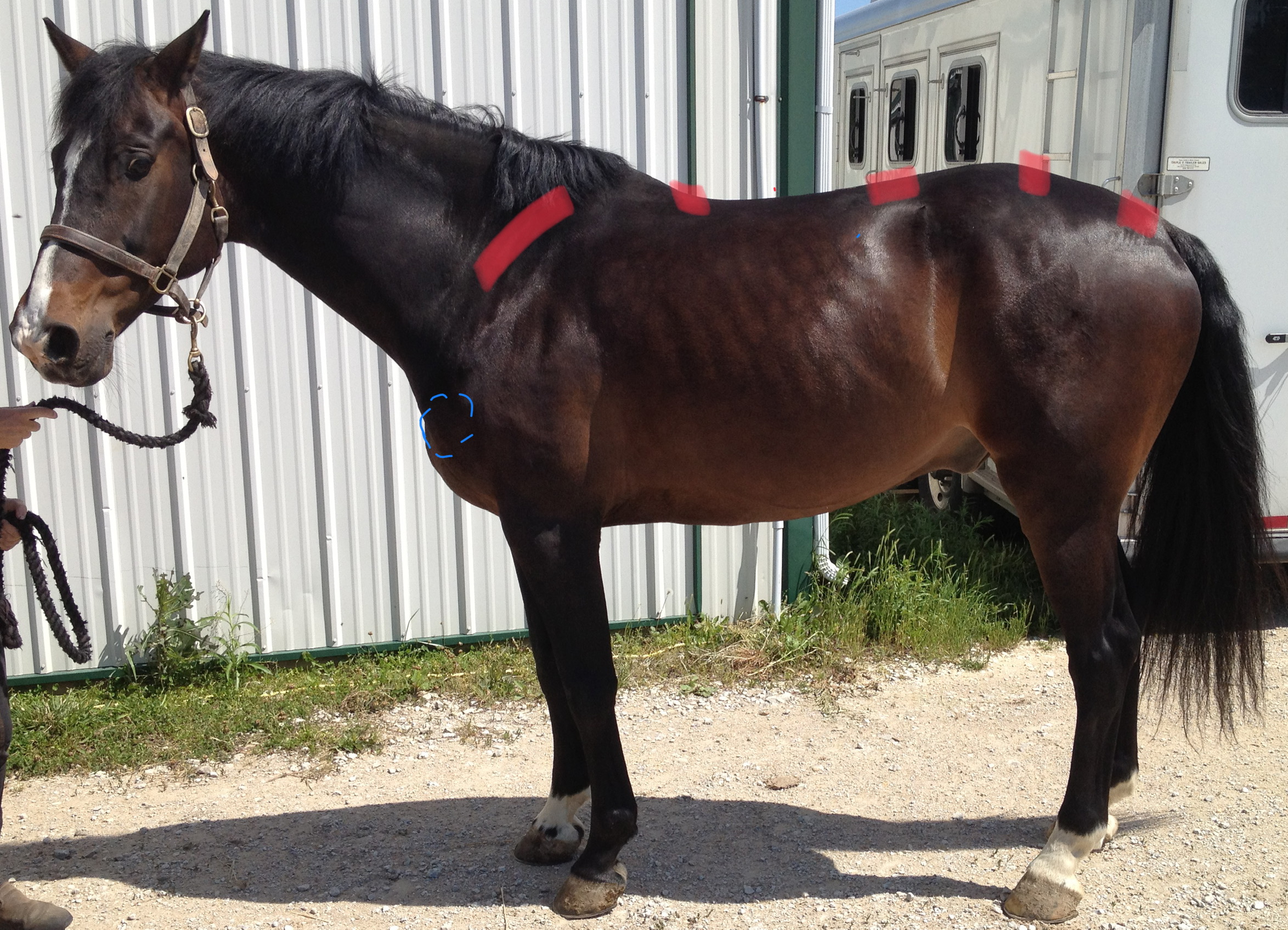
CPG #16 Subscapularis Syndrome Gait
CPG#16 Bilateral Subscapularis Syndrome Gait
This weak indicator muscle between the shoulder and rib cage stabilizes the shoulder joint. Also involved with this CPG dysfunction is a muscle high on the inside of the hind leg which stabilizes the sacroiliac joint. These horse stand with their shoulders forward and winging out along with some sensitivity to flank/inguinal area. Resolution of this deficit requires correcting chiropractic issues in the thoracic, lumbar, sacral and coccygeal vertebrae.
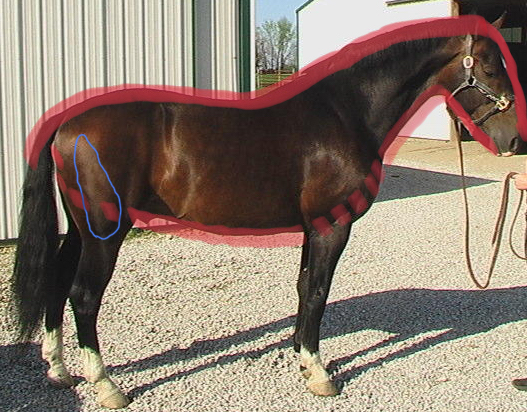
CPG #17 Pace Gait
CPG#17 Pace Gait
The weak indicator muscle is the Biceps femoris muscle in back, outside part of the hind leg. This leg muscle will stabilize the hip, stifle and hock. A subconscious pain source usually on the midline will cause this CPG dysfunction. Examples would be castration or scars on back or belly along with dental issues.
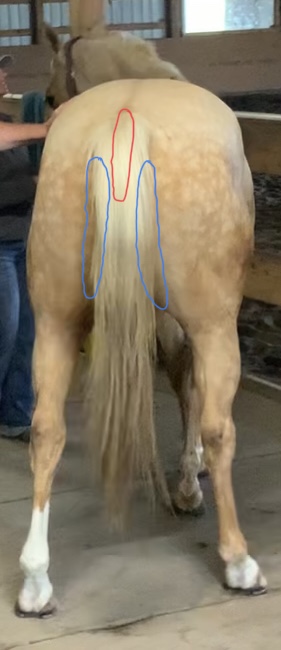
CPG #18 Semimembranosis Gait
CPG#18 Semimembranosus Gait
The weak indicating muscle is the semimembranosus muscle on the inside of the hindleg under the tail. This muscle stabilizes the hip, stifle and hock and secondarily the fetlock/pastern/coffin joint. Usually this CPG deficiency is created by a chiropractic issues in the tail.
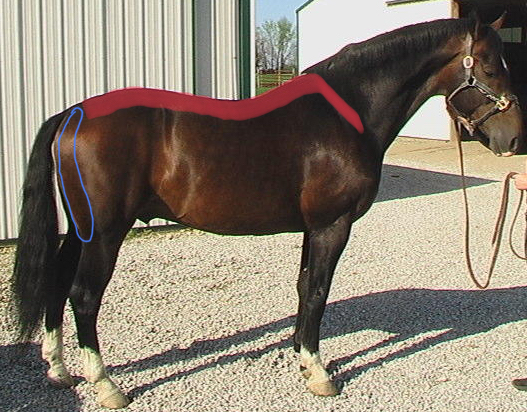
CPG #19 Semitendinosus Gait
CPG#19 Semitendinosus Gait
The weak indicating muscle is the semitendinosus muscle which in located on back of hind leg about were the edge of tail hangs. This muscle stabilizes the hip, stifle, hock. This CPG dysfunction results from a chiropractic issue in the thoracic, lumbar or sacral area of the spine.
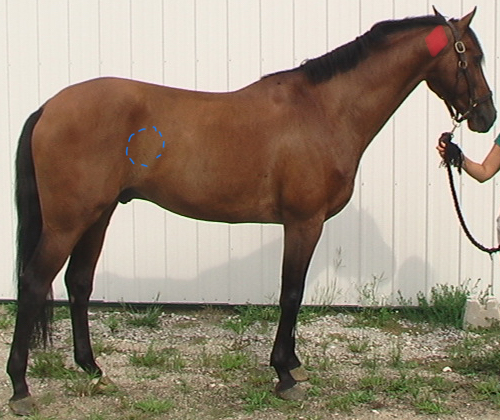
CPG #20 Illeocecal Valve Dysfunction
CPG#20 Illeocecal Valve Dysfunction
This CPG deals with intestinal tract motility not musculoskeletal biomechanical function. This CPG is common in horses experiencing colic. The illeocecal valve is the pacemaker for the intestinal tract. With this CPG dysfunction the motility of the intestinal tract is compromised allowing gas distention or impaction. Usually a chiropractic issue occurring in the second cervical vertebrae initiates this CPG deficit. Some colic episodes can be resolved by correcting this dysfunction.
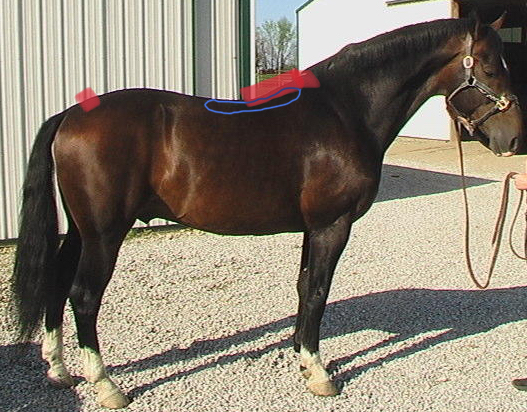
CPG #21 – Cluneal Nerve (Thoracici cutanei mediales dorsales nerve) Entrapment
CPG#21 Cluneal Nerve (Thoracici cutanei mediales dorsales nerve) Entrapment
Although the horse does not have a Cluneal nerve the name is extrapolated from human anatomy and back pain. The Thoracici cutanei mediales dorsales (TCMD) nerves are entrapped by muscles along the back above the ribs.
These horses with this dysfunction are generally back sore. Although not always, it is not uncommon for this CPG dysfunction to be initiated by a poor fitting saddle. Horses with this issue may not like being saddle, buck or refuse to go forward when saddled. Chiropractic issues in the thoracic vertebrae initiate this CPG dysfunction. This CPG deficit maybe a component of the kissing spine syndrome in the horse.
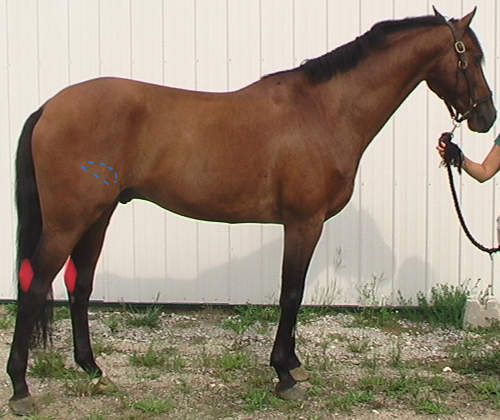
CPG #22 Pubic Tendon Gait
CPG#22 Pubic Tendon Gait
Of all the CPG deficits, this can be the most painful when it occurs. The pubic tendon is where all the abdominal muscles attach to the front of the pelvis.
In the Bow and String Theory of Collection in the horse, the pubic tendon is key component of pelvic flexion and cocking the bow before release. These horses are reluctant to flex their pelvis or use their hind legs to push off. Injury Recall Technique is used to correct the pathology in the pubic tendon.
Extreme caution needs to be used in correcting this deficit, since some horses will violently kick, bite, buck or even try sit or lay down when correcting.
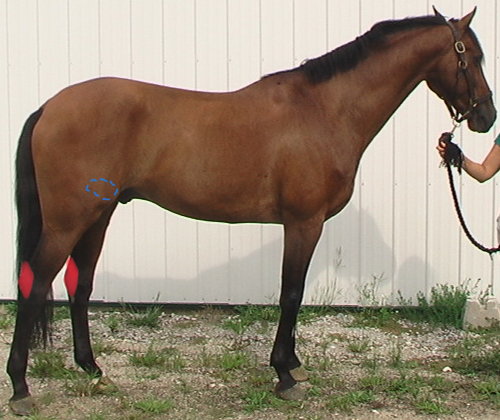
CPG #23 Gelding Scar Dysfunction
CPG#23 Gelding Scar Dysfunction
As the name implies, this CPG deficit originates from the gelding scar. When the gelding surgery occurs, the process goes through a tissue layer called the fascia. The fascia is like a piece of cellophane wrapped around the body and the muscles. So as the fascia heals post-surgery, a scar develops in the fascial plane. An aggressive pulling scar puts tension in the fascial plane. This tight fascia can restrict the movement of musculoskeletal system especially in the hindquarters. The deficit is corrected by using an Injury Recall Technique on the gelding scar. Extreme caution needs to be used in correcting this deficit, since some horses will violently kick, bite, buck or even try sit or lay down when correcting.
